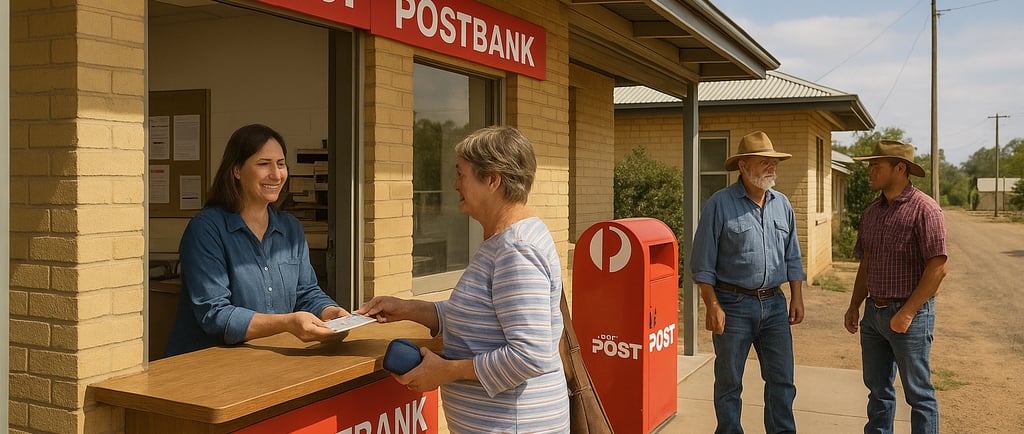Reimagining Access: The Case for a Postbank in Rural and Remote Australia
Access to reliable, affordable banking is disappearing from rural and remote Australia. As major banks withdraw services, communities are left vulnerable without access to cash, credit, or secure savings. This blog post explores the growing call for a publicly owned Postbank: a solution rooted in trust, infrastructure, and social value. We examine its potential to empower regional economies, support Indigenous communities, and restore financial inclusion where it’s needed most.
REMOTE LIFE
7/18/20254 min read


Introduction
Access to basic banking services is a cornerstone of economic participation, personal security, and social inclusion. Yet, for millions living in rural and remote Australia, particularly Indigenous communities, the slow withdrawal of major banks has created financial deserts—areas where banking is either unaffordable, impractical, or entirely absent. The concept of a Postbank, a public banking service operated through Australia Post outlets, offers a historically grounded and future-ready solution to this pressing issue.
A Brief History: Banking Services in Rural Australia
The origins of accessible banking in regional Australia were closely tied to the establishment of post offices. In the 19th and early 20th centuries, Australia's postal system extended deep into the country’s sparsely populated interior, often being the only government presence in remote towns. Post offices provided a wide array of services, including rudimentary financial transactions like money orders and savings bank deposits through institutions such as the Commonwealth Savings Bank, founded in 1912.¹
In the late 20th century, however, significant changes began to erode these services. The privatisation of the Commonwealth Bank (1991–1996) and the rationalisation of rural branches led to widespread bank closures.² By 2020, over 60% of regional bank branches had shut down,³ disproportionately impacting communities without reliable internet or transport links.
Australia Post partially filled the gap through the Bank@Post service, a partnership allowing certain transactions at post offices. However, the service is limited in scope, and many participating banks are themselves closing branches or reducing access.
What Is a Postbank?
A Postbank is a government-backed financial institution operating through the post office network. These models exist globally, including:
New Zealand’s Kiwibank, created in 2001 as a public bank using the NZ Post network⁴;
Japan Post Bank, which holds one of the largest deposit bases in the world;
La Banque Postale in France, which has a universal service obligation.
Australia could emulate this by creating a publicly owned bank using the national network of over 4,300 Australia Post outlets, many of which are already serving communities that no commercial bank does.
Why Small Regional Communities Need a Postbank
The closure of bank branches has left many regional Australians without face-to-face banking. Digital alternatives do not solve the issue for the elderly, those with limited literacy, and people in areas without stable internet.
Key benefits of a Postbank in small regional communities include:
1. Reliable Access to Cash and Services
Essential services—like deposits, withdrawals, loans, and bill payments—can be delivered in person, via trained post office staff, maintaining a community’s financial autonomy.
2. Support for Small Business and Farmers
Regional SMEs often face challenges accessing credit from commercial banks. A public bank could offer affordable, ethical lending products suited to the rhythms of rural economies.⁵
3. Local Economic Multipliers
Money that circulates locally—rather than being extracted via dividends to commercial shareholders—can stimulate regional economic development and resilience.⁶
4. Safeguarding Financial Inclusion
Public banks are less likely to close unprofitable branches. A Postbank would serve as a stable, non-commercial anchor institution in places where private banks see no business case.
Why Remote Indigenous Communities Need a Postbank
In many remote Indigenous communities, access to physical banking is either non-existent or predatory. Community members often travel hundreds of kilometres to the nearest town, relying on expensive or unsafe transport options.
1. Preventing Exploitation
The absence of basic banking services exposes people to predatory lenders, cashless welfare card abuse, or coercive transactions in informal economies. A trusted, publicly governed Postbank could restore agency and financial rights.
2. Improved Financial Literacy and Safety
Face-to-face banking in culturally safe environments fosters trust and understanding. The use of local Indigenous staff at Postbank counters could build financial literacy, reduce fraud, and enable informed financial decision-making.⁷
3. Secure Access to Government Payments
Access to pensions, Centrelink, or disability payments via a reliable, community-embedded bank would reduce travel, stress, and the loss of funds to fees. This is particularly important in communities with minimal digital infrastructure.
4. Culturally Appropriate Governance
A Postbank can work in partnership with Indigenous organisations to co-design service delivery, improving cultural safety and aligning with self-determination principles embedded in the Uluru Statement from the Heart.⁸
A Postbank Is Not a Step Back—It’s a Leap Forward
While some may view a Postbank as a “last resort” for declining towns, it is in fact a forward-thinking model that integrates physical presence, public interest, and technological infrastructure to rebuild trust and economic capacity. It can serve as an anchor for broader services, including digital literacy programs, microfinance, housing assistance, and social service referrals.
As Australia contemplates financial equity in a digital-first economy, the Postbank stands as a low-risk, high-impact proposal ready for legislative and operational implementation.
Conclusion
Banking is not a luxury—it is a right that underpins civic participation and financial independence. The rapid commercial retreat from regional Australia has left behind communities that remain vital to our national identity and economy.
By drawing from successful international models and revitalising a trusted institution—Australia Post—we have the opportunity to reclaim equitable access to banking, particularly for rural towns and Indigenous communities. A Postbank is more than a bank. It is a commitment to inclusion, resilience, and shared prosperity.
References
Reserve Bank of Australia. (2017). The Evolution of Banking in Australia. Retrieved from: https://www.rba.gov.au
Commonwealth Bank. (1996). Privatisation History. Retrieved from: https://www.commbank.com.au/about-us/our-company/our-history.html
Australian Competition and Consumer Commission (ACCC). (2021). Regional Banking Taskforce Report.
Kiwibank. (2021). About Us. Retrieved from: https://www.kiwibank.co.nz/
Australia Institute. (2020). The Case for a Public Bank. Retrieved from: https://australiainstitute.org.au/
Public Banking Institute. (2019). Banking in the Public Interest. Retrieved from: https://www.publicbankinginstitute.org/
Good Shepherd Microfinance. (2018). Financial Inclusion Action Plan for Indigenous Australians.


Far North Consulting Pty Ltd t/a Groundwork Consulting
© 2025 Groundwork Consulting
ABN 77 649 525 806
MAKING GOOD IDEAS WORK
Video Platform Links





